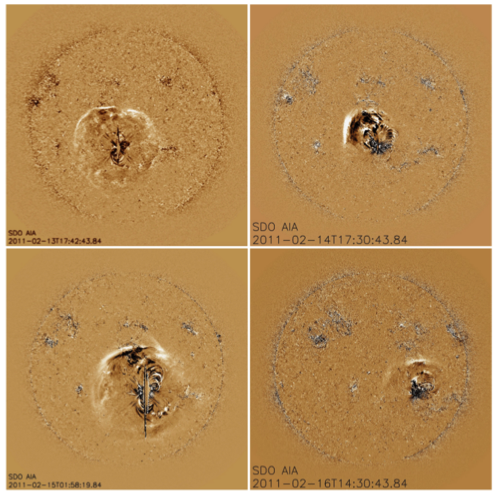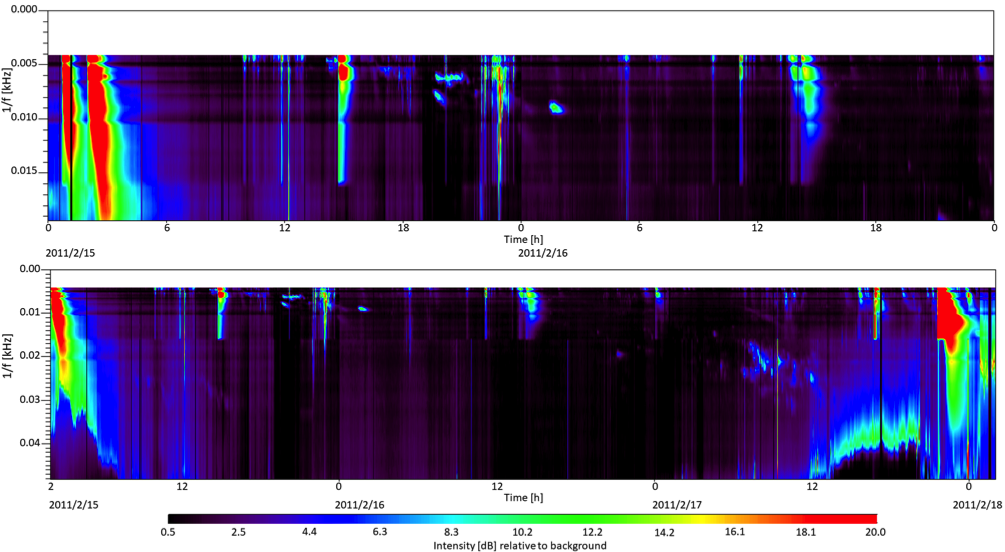During its transit through central meridian, and along four consecutive days, from 13 to 16 February 2011, NOAA active region (AR) 11158 generated coronal mass ejections (CMEs) in association with waves observed in the extreme ultraviolet (EUV) low corona, and even with a Moreton wave. On those dates, the spacecraft of the STEREO mission were located in quadrature with SOHO and SDO, enabling the exceptional observation of this series of Earth-directed events. Moreover, low-frequency radio emissions registered by the WAVES experiment aboard the Wind spacecraft allows tracking of the events in the interplanetary medium. These circumstances motivate a joint analysis of the four coronal wave events, their associated CMEs, and interplanetary radio counterparts, by means of observations from multiple viewpoints and at various wavelengths.
The active region and ensuing CMEs
AR 11158 is one of the most studied active regions in recent years, mainly due to the atypical number of solar flares associated with this region that occurred in a relatively short time interval. This AR was formed by two large bipolar regions, which emerged almost simultaneously on 9 February 2011. After developing rapidly, the region produced along its transit through the solar disk a large number of flares. In particular, during four consecutive days, the active region produced four intense flares accompanied by EUV coronal waves and important CMEs largely directed towards Earth. Despite originating in the same region and under apparently similar conditions, all coronal wave fronts exhibit different characteristics, in particular with respect to their projected propagation direction, which in some events seem to have a preferential direction (see Francile et al. 2018 and Figure 1).
 Figure 1. EUV waves on days 13, 14, 15, and 16 February 2011 in running-difference images from the Atmospheric Imaging Assembly aboard the Solar Dynamics Observatory.
Figure 1. EUV waves on days 13, 14, 15, and 16 February 2011 in running-difference images from the Atmospheric Imaging Assembly aboard the Solar Dynamics Observatory.
The three-dimensional properties of the CMEs associated with the four EUV wave events that took place on 13-16 February 2011 were deduced by means of the Graduated Cylindrical Shell (GCS) forward model by Thernisien et al. (2009). This 3D model was fit to the triplets of nearly simultaneous images obtained by the coronographs C2 and C3 onboard SOHO and the COR2 (A and B) coronographs of the STEREO Mission, located at different vantage points for the dates of the analysis. The parameters resulting from the GCS fits are displayed in Table 1. From left to right, the columns display: date of the event, central Stonyhurst heliographic coordinates of the modeled CME, tilt angle of its main axis, angular width along the main axis and perpendicular to it, and speed of the frontal structure.
| Date | Coordinates
(Lat., Lon.) |
Tilt | AWL | AWD | Speed |
| 13 Feb 2011 | 5.2,0.0 | -15 | 77 | 47 | 180 |
| 14 Feb 2011 | 3.9,10 | -11 | 120 | 56 | 330 |
| 15 Feb 2011 | -6.5,0.0 | 38 | 120 | 74 | 1160 |
| 16 Feb 2011 | 3.0,32 | 21 | 34 | 14 | N/A |
Table 1. GCS model fit parameters. All values are in degrees, except speed in km s-1.
Type II low frequency emissions
The low frequency type II radio emissions detected by the Thermal Noise Receiver (TNR), as part of the WAVES experiment onboard Wind, enable the interplanetary tracking of the shock waves driven by CMEs propagating toward Earth. In their journey through the interplanetary medium, the frontal shock waves of CMEs excite electrons that in turn emit at the local plasma frequency. The latter is directly proportional to the local plasma density, implying a decrease of the frequency of the type II emission as the shock propagates away from the Sun and density lessens.
Detections of enhancements of these radio emissions have been attributed to the interaction of a fast CME and its shock wave, with another slower structure (Gopalswamy et al. 2001). We interpret the enhancement of the radio emission on 15 February 2011 at ~22:00 UT (see Figure 2, top panel) as indicative of the interaction of the fast CME that commenced early on the day, with the CME on 14 February 2011. When adding 17 February 2011 to the dynamic spectrum (Figure 2, bottom panel) an enhancement in the radio emission is seen starting around 08:00 UT on that day. Kinematic considerations suggest that this enhancement could be related to the interaction of the ensemble of CMEs on days 14 and 15 with the previous CME on 13 February 2011.
 Figure 2. TNR dynamic spectrum during 15-16 February (top) and 15-18 February (bottom) exhibiting enhancements attributed to the interaction of interplanetary structures.
Figure 2. TNR dynamic spectrum during 15-16 February (top) and 15-18 February (bottom) exhibiting enhancements attributed to the interaction of interplanetary structures.
Conclusions
This article describes the eruptions associated with EUV waves produced by the super-active AR 11158 during four consecutive days. Despite the apparently similar environmental conditions associated with the eruptions, and their proximity in time, the resulting CMEs exhibit remarkably different kinematic and morphological features. On the other hand, it is speculated that the enhancement of the radio signal during the type II emission on 15 February 2011 would be indicative of the interaction with the event of the previous day. The differing characteristics of the CMEs, in particular with respect to their speed and consequently their kinetic energy, make possible a scenario in which the slower CMEs of the 13 and 14 February 2011 are reached and assimilated by the fastest and most massive one on the 15th.
Based on recent paper: Cremades, H., López, F. M., Mandrini, C. H., Gulisano, A., Francile, C. N., Cristiani, G., Gutierrez-Escate, M. V.: 2018, BAAA, 60, 216
References
Francile, C. N., López, F. M., Cremades, H., et al.: 2018, BAAA, 60, 210
Gopalswamy, N., Yashiro, S., Kaiser, M. L., et al.: 2001, ApJ, 548, L91
Thernisien, A., Vourlidas, A., Howard, R. A.: 2009, Sol. Phys., 256, 111
*Full list of authors: Hebe Cremades, Fernando M. López, Cristina H. Mandrini, Adriana Gulisano, Carlos N. Francile, Germán Cristiani and María V. Gutierrez-Escate
